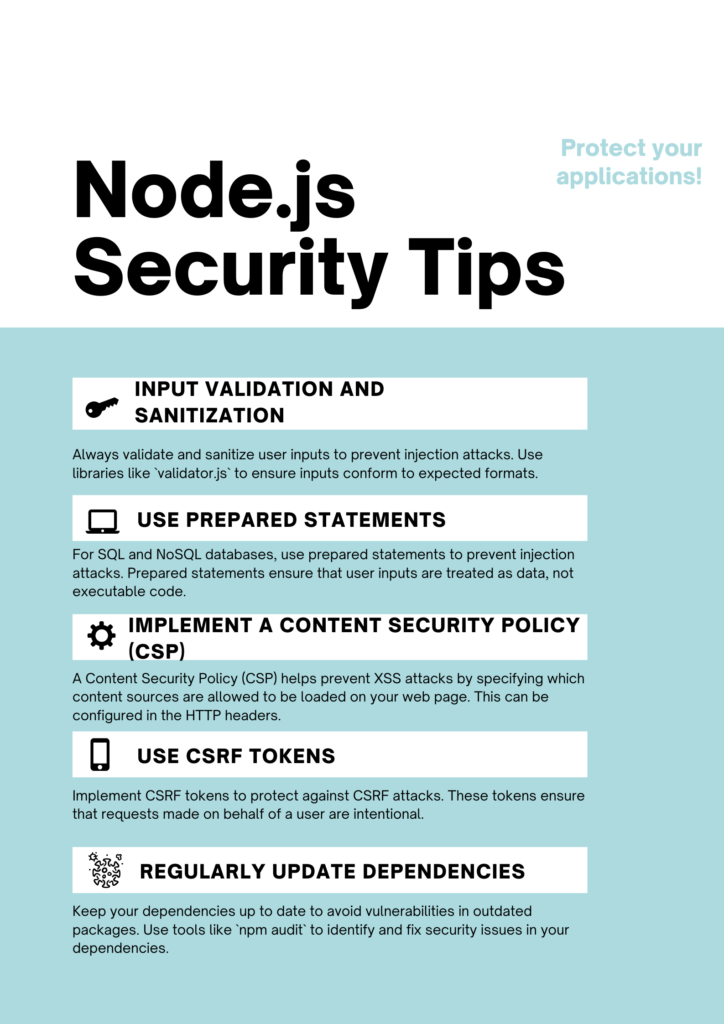Node.js is a popular choice for building fast and scalable network applications. However, its rise in popularity has put your node.js application at risk. Ensuring the security of your Node.js application is important to protect sensitive data and maintain user trust. We will, therefore, look at common security threats, for example: injection attacks and cross-site scripting (XSS) and provide best practices for securing a Node.js application.
Is your node.js application at risk?
Firstly, understanding the common security threats is the first step in securing your Node.js application. To explain the various security threats, we will cover some of the most prevalent threats you need to be aware of:
Injection Attacks that put your node.js application at risk
Injection attacks, for example: SQL injection and NoSQL injection, occur when an attacker manipulates a query by injecting malicious input. This can lead to unauthorized access to data, data corruption, or even system compromise.
Cross-Site Scripting (XSS) that puts your node.js application at risk
Also, Cross-Site Scripting (XSS) is a vulnerability that allows attackers to inject malicious scripts into web pages viewed by other users. These scripts can, therefore, interfere with security in ways such as: steal user data, hijack user sessions, or deface websites.
Cross-Site Request Forgery (CSRF) that puts your node.js application at risk
Also, Cross-Site Request Forgery (CSRF) tricks a user into performing actions they didn’t intend to, such as changing account details or making transactions. In particular, it exploits the trust a web application has in the user’s browser.
Insecure Dependencies that put your node.js application at risk
In addition, using outdated or vulnerable packages and modules can expose your application to security risks. As long as attackers can exploit known vulnerabilities in these dependencies to compromise your application, you need to be careful of your dependencies.
Best Practices for Securing Your Node.js Application Against Threats

As a result of the dangers posed by these security threats, it is important to look at the various ways in which we can protect our node.js applications.
Input Validation and Sanitization for your Node.js application
Always validate and sanitize user inputs to prevent injection attacks. In addition, use libraries, such as`validator.js` to ensure inputs conform to expected formats.
const validator = require('validator');
if (validator.isEmail(userInput)) {
// Safe to use
} else {
// Handle invalid input
}Use Prepared Statements for your Node.js application
Also, for SQL and NoSQL databases, use prepared statements to prevent injection attacks. Prepared statements ensure that user inputs are treated as data, not executable code.
const query = 'SELECT * FROM users WHERE email = ?';
connection.query(query, [userEmail], (err, results) => {
// Process results
});Implement a Content Security Policy (CSP) for your Node.js application
Additionally, a Content Security Policy (CSP) helps prevent XSS attacks by specifying which content sources are allowed to be loaded on your web page. This can be configured in the HTTP headers.
app.use((req, res, next) => {
res.setHeader('Content-Security-Policy', "default-src 'self'");
next();
});Use CSRF Tokens for your Node.js application
Meanwhile, implementing CSRF tokens helps to protect against CSRF attacks. These tokens, therefore, ensure that requests made on behalf of a user are intentional.
const csrf = require('csurf');
app.use(csrf());
app.get('/form', (req, res) => {
res.render('send', { csrfToken: req.csrfToken() });
});Regularly Update Dependencies for your Node.js application
Also, keep your dependencies up to date to avoid vulnerabilities in outdated packages. Use tools like `npm audit` to identify and fix security issues in your dependencies.
npm audit fixUse HTTPS for your Node.js application
Lastly, encrypt data in transit by using HTTPS. This prevents attackers from intercepting sensitive information between the client and server.
const https = require('https');
const fs = require('fs');
const options = {
key: fs.readFileSync('server-key.pem'),
cert: fs.readFileSync('server-cert.pem')
};
https.createServer(options, app).listen(443);Enhancing the security of your Node.js application with Pipeops
Furthermore, to enhance the security of your Node.js application, consider integrating comprehensive logging and monitoring solutions. Pipeops provides a robust logging and monitoring service to detect and respond to security incidents in real-time. Additionally, by tracking suspicious activities and potential threats, PipeOps enables you to take immediate action and mitigate risks effectively. This, therefore, gives a proactive approach that not only helps in identifying security breaches early but also assists in maintaining the overall health and performance of your application.
Conclusion
In conclusion, securing your Node.js application requires a proactive approach to identify and mitigate potential threats. Therefore, by understanding common security vulnerabilities such as injection attacks and XSS, and implementing best practices like input validation, prepared statements, and using HTTPS, you can significantly enhance the security of your application. Additionally, integrating logging and monitoring solutions like PipeOps can provide an extra layer of protection by detecting and responding to security incidents promptly.






